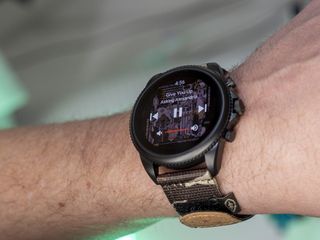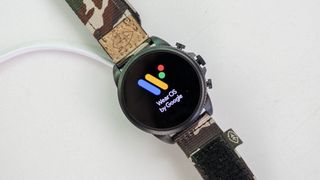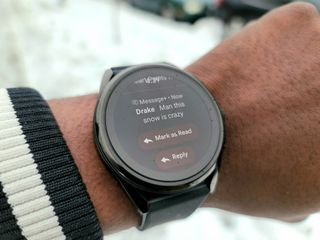Fossil Gen 7: 7 things we want to see in the next-gen Wear OS smartwatch
Our Fossil Gen 7 wishlist has some obvious picks and some not-so-obvious ones.

Fossil has been a Wear OS mainstay for quite some time now and, at one point, had some of the best smartwatches you could find running Google's wearable OS. However, the landscape has changed thanks to the upcoming Wear OS update and Google's renewed focus on improving the platform. The company's last smartwatch launch came at a fairly awkward time, but the stars could align just right for the Fossil Gen 7.
The company has a chance to right some of the wrongs that came around with the launch of the Fossil Gen 6, assuming it can learn from them. Here are some of the things we would like to see in the eventual Fossil Gen 7 smartwatch.
Wear OS 3

This is probably the most obvious, but it would be nice if Fossil Gen 7 smartwatches shipped with Wear OS 3 onboard. Google has held off giving OEMs access to Wear OS 3, aside from Samsung, and we have yet to learn when exactly current smartwatches will be upgraded to the new operating system. However, by the time Fossil Gen 7 rolls around, Wear OS 3 should be on a lot more smartwatches and ready to ship on the next-generation devices.
Google has promised that Wear OS 3 would bring better battery life, in addition to faster performance and new capabilities. The Galaxy Watch 4 isn't exactly known for its stamina, but it still lasts longer than Fossil smartwatches on average. Hopefully, Wear OS can help Fossil squeeze out more battery life, but of course, part of that responsibility falls on Fossil as well.
Better battery life (and keep the fast-charging)

Battery life has been one of the main downfalls of Fossil smartwatches. It likely has to do with either inefficient chipsets, small batteries, the battery-hungry wear OS 2.x, or some combination of the three. Fossil has control of at least one of these, and it's something that Gen 6 failed to address.
In my Skagen Falster Gen 6 review, I noted that the device could really only make it through a day on regular smartwatch mode, which isn't very impressive. Meanwhile, Mobvoi has continued to stuff larger batteries into its smartwatches like the TicWatch Pro 3 Ultra, which can easily last three days in regular use. For Wear OS, that's quite impressive and something I'd love to see on Fossil's next-generation smartwatch.
Of course, a bigger battery can only do so much. Fortunately, Fossil offers incredibly fast charging on its latest smartwatch, and that's definitely a feature that needs to carry over.
Be an expert in 5 minutes
Get the latest news from Android Central, your trusted companion in the world of Android
LTE connectivity for everyone

Fossil finally dove into LTE connectivity with Gen 5 LTE smartwatch, but it was limited to Verizon, leaving out T-Mobile and AT&T customers. The company curiously skipped out on an LTE version of the Gen 6 smartwatches. This is unfortunate because one of the best things about owning a smartwatch is being able to leave your phone at home while on a run or something, knowing that your smartwatch will keep you connected to calls and texts when you need them while leaving most other distractions at home.
In the US, the Galaxy Watch 4 is really the only smartwatch you'll find in all carrier stores, so it would be nice to Fossil would offer more LTE connectivity. This should not only help with Wear OS sales, but it would help Fossil by giving it more visibility. After all, I can't imagine Fossil's website would be the first place the average consumer would look if they were in the market for a smartwatch.
Sizes (and styles) for everyone

This isn't something that has been much of a concern for me, but I know there are plenty of people with smaller wrists that would prefer smaller case sizes for smartwatches. When Fossil launched its previous-generation smartwatch, it was only available in one case size, and some found it too big. The Fossil Gen 5E sort of addressed this, but that came at the expense of some features. Fortunately, Fossil's latest smartwatch comes in two case sizes, 42mm and 44mm.
Perhaps the next generation should have three different sizes with an even smaller Fossil Gen 7E launching alongside two larger versions. The smaller watches should come with the full set of features, similar battery life, and should not be limited to gaudy designs that Fossil thinks will only appeal to women.
Better fitness tracking, too

Smartwatches are becoming much more advanced with each generation, offering plenty of sensors to give users a comprehensive review of their health. Fossil stepped things up a little with a Gen 6 smartwatches, finally offering SpO2 monitoring. However, that's nothing compared to the new BIA sensor that Samsung included on its Galaxy Watch 4, which can give users a look at their body composition. Samsung also has ECG and blood pressure monitoring in many regions where its watch is sold, making the Galaxy Watch one of the best Android smartwatches for general health and fitness tracking.
It's time for Fossil to step up its game even more. Samsung has yet to enable blood pressure monitoring in the United States, giving Fossil an opportunity to beat it to the punch. Also, while I'm already impressed with Fossil's sleep tracking capabilities, I find its activity tracking to be pretty lacking. I want to be able to start a workout and have my watch automatically track it without me having to do it manually every time. Oftentimes I forget to either start tracking or stop it, which can really mess things up if I'm trying to stay on top of my fitness. I want the Fossil Gen 7 to be a good smartwatch and a great health and fitness tracker.
Fingerprint sensor

This one's a bit out there, but I've always wanted to see a smartwatch with a fingerprint sensor. I find it a little bothersome having to use a pin or pattern to unlock my smartwatch or use it for Google Pay purchases. I want to be able to tap my finger on my watch the same way I do with my smartphone to unlock or make payments.
I can imagine possibly using a side-mounted sensor, although that would mean Fossil would have to get rid of the rotating crown or one of its side buttons. The other option, of course, would be to use an in-display sensor, which is something Samsung was reportedly working on at one point. We have yet to really see this on a smartwatch, so it'd be cool for Fossil to make it a reality.
Something unique

For years, the Fossil was the vanguard of Wear OS, being one of the few manufacturers to essentially keep the operating system alive while Google seemingly twiddled its thumbs. However, with Samsung now on board with wear os and the Pixel Watch on the way, Fossil really has to stand out. Samsung has its suite of services and its integration of Galaxy smartphones that make its smartwatches really enticing. The Pixel Watch will no doubt get a huge push from Google, banking on Pixel smartphone integration and being the first to feature Fitbit software. With this increase in competition, Fossil really needs to give us a reason to care.
Wear OS 3 is a lot more open to customization than previous versions of the platform, so Fossil can always take advantage of that to give us a unique take on the operating system. Since Fossil doesn't have a smartphone, it can be the de-facto watch for anybody, offering all its best features for any Android smartphone you attach to it. Thanks to the so-far exclusive Alexa app, the company is already at a decent start, giving anyone within the Amazon ecosystem quick access to the voice commands from their wrist. This comes at a time when Samsung is struggling to give us Google assistant on its own smartwatch as an alternative to Bixby. However, I think Fossil can do a lot more to make its watches stand out, whether it's through design, hardware, features, etc.
Don't give in to Samsung and Google
Thanks to Samsung, Wear OS has captured a sizeable share of the smartwatch market, and things are only poised to get better with the introduction of the Pixel Watch. With the growing popularity of Google's wearable platform, Fossil has an opportunity to take advantage and regain lost ground. However, it can only do so if it has the guts to put its all into its next smartwatch, lest it remain overshadowed by Samsung and Google.

Derrek is a long-time Nokia and LG fanboy who loves astronomy, videography, and sci-fi movies. When he's not working, he's most likely working out or smoldering at the camera.
